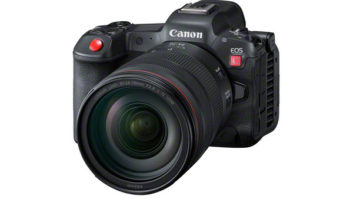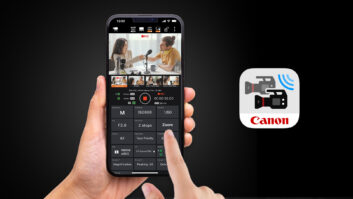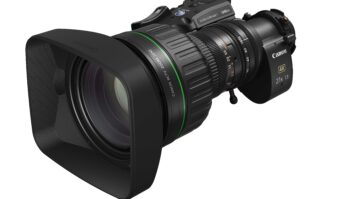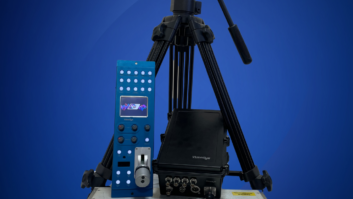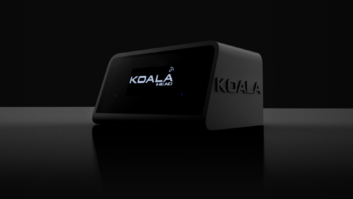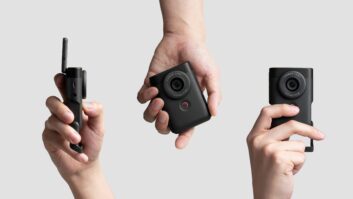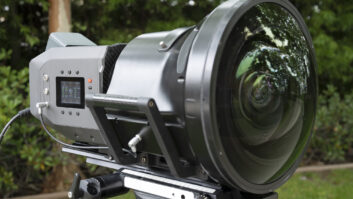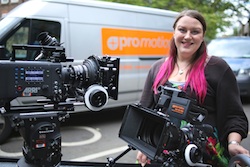
Canon’s C300 camera appears to be leading the way in bringing large sensor shooting to mainstream television. Until recently, shooting with large sensor cameras either meant big budgets, using digital cinema cameras like Arri’s Alexa, or the compromised ergonomics and limited controls of a DSLR. Now, there are several mid-range S35mm cameras to choose from, including Sony’s F3, FS100, and FS700, and Blackmagic Design’s innovative, but slightly smaller sensored, Digital Cinema Camera.
For the moment, Canon’s C300 is the most in-demand large-sensor camera for mainstream broadcast, even for observational documentaries — an area where you might think the shallow depth of field would be a disadvantage but where its low-light capabilities have proved useful.
“The C300 is the most popular camera” for rental, according to Katie Thomas (pictured above), Business Development manager, Pro Motion Hire. The C300 is “the most requested of all our cameras,” adds Olly Wiggins, DoP and managing director of S+O Media. “It’s a very affordable 35mm sensor that also hits the 50Mbps mark. A lot of people who used to shoot with DSLRs are using it.”
Most users opt for the EF-mount version, as the PL-mount model requires more expensive lenses PL-mount lenses – although they offer smoother iris control. “The EOS [EF] lenses stutter as the iris moves in changes of a third of a stop,” says Wiggins.
S+O has six EF C300s and three PL. The quality is good enough for use on feature films. S+O hired two PL versions to the new Tom Hanks/Paul Greengrass movie, Captain Phillips, for use alongside Alexas and film cameras – mainly for night scenes or in confined spaces.
Safety net
Freelance Lighting Cameraman and DoP Tim Sutton bought the first C300 in the UK. “Buying the first of anything is always a bit of a gamble,” but it has paid off, because the C300 is now flavour of the moment and is “perfect for TV”.
He didn’t consider buying any other large-format camera at the time as nothing else ticked all the boxes for picture quality, usability, cost and specification — mainly the TV friendly codec. “It delivers good looking pictures, is easy to use and producers are not bewildered with yet another format or codec given the C300’s workflow is identical to that of the XF305.”
Sutton loves the safety net offered by dual slot recording and the fact that he can provide a very affordable package with a large selection of quality prime, zoom and specialist EF lenses. However, the C300 does need to be used with a rig and other accessories, like the new TV Logic/Alphatron Viewfinder.
Sutton has used the C300 for a wide range of productions, from drama to commercials, and “increasingly on documentaries and current affairs, alongside my 2/3-inch camera,” using the C300 for pretty shots and interviews and his Sony F800 for handheld actuality or fast-paced situations.
The Super35 sensor look is useful for him on high-end documentary work “where look and an emotive image is increasingly more important. A shallow depth of field helps make unfriendly small locations I’m often confronted with on current affairs programming look a lot better.”
Depth of field
S+O still rents out DSLRs in large numbers, “but the C300 has cornered a huge amount of the market,” says Wiggins. C300 kits cost from about £250 a day, including a couple of lenses, only marginally more than a Canon 5D MkII kit (which then needs separate audio and still wouldn’t be accepted as HD by broadcasters). Shallow depth of field is a key attraction of the larger sensor cameras, but then you have “problems of holding focus,” he adds.
“There’s a huge amount of hype behind [the C300] because of what it offers for the price, but it doesn’t necessarily fit all filming styles. It wouldn’t necessarily be particularly easy to use it for documentary or reality or a fast-paced entertainment shoot.”
It doesn’t have long zoom lenses (such as the 22x) that are available for the B4-mount. Typically, S+O’s clients take a minimum of a 24-70mm f2.8 and a 70-200mm f2.8, and often an EOS 50mm f1.2 for extreme shallow depth of field, which Wiggins (pictured) says is particularly good for portrait shots.
However, “it is probably the best camera out there for low light,” he adds.
“A lot of people are put off by the C300’s small size and amount of buttons in comparison even to some of its direct competitors. For broadcast, connecting accessories like radio mics does prove problematic especially when operators have been used to the more traditional ENG-style cameras,” says Thomas.
Like the Alexa, it has Log Gamma recording to help capture a higher dynamic range. “This is something normally seen in high end cameras. To be able to shoot log on a £10k camera is very impressive,” she says.
Tim Sutton is not tempted by the Blackmagic Design Digital Cinema Camera or 4K cameras like the C500. He doesn’t like the Blackmagic’s ergonomics, the way its connectors are mounted directly to the internal printed circuit boards and its sensor size, but “it is a clever bit of independent design thinking and will appeal to filmmakers who want to evoke a 16mm film look for cinema,” he says. Although “on paper it looks fantastic,” Wiggins points out the Blackmagic does have a more cropped sensor than the S35 cameras.
The C500 should arrive in November, and Wiggins says he “will probably buy it, but not in the same numbers as the C300 — especially as it will need an external recorder for 4K, so will cost almost as much as a Red Epic but without many of the Epic’s features.
“I think 4K recording will take a lot longer to take off. It will grow slowly, and probably for films first. The Alexa has shown that a 2K image is very usable. You don’t necessarily need to ramp everything up to 4K.” He believes that 4K will prove problematic in post, especially at TV budgets, where 4K would only be viable if you are doing a lot of effects work for promos or commercials. “Most people are very happy with HD and 50Mbps.”
David Fox
www.promotionhire.co.uk
www.somedia.tv
www.timsutton.tv
